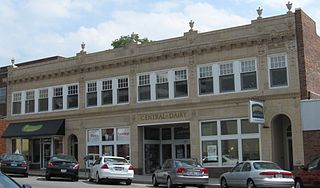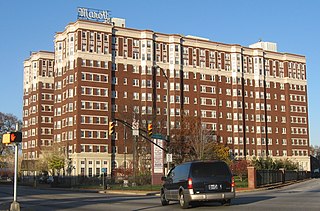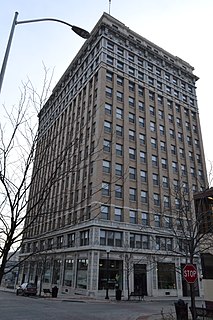
The Failing Office Building is a building in downtown Portland, Oregon, United States that was listed on the National Register of Historic Places on October 31, 2007. The building was built during the rapid growth in Portland's business district after the Lewis and Clark Centennial Exposition in 1905. It was built with six stories in 1907, with a six-story addition in 1913. It features a reinforced steel-frame structure with facades of yellow brick and glazed terra cotta.

The Ballenger Building, also known as G.F. Troxell Furniture Store, Taylor Music and Furniture Co., and Safeway, is a historic commercial building located in downtown Columbia, Missouri. It was originally built about 1892, and expanded rearward about 1904. It was extensively remodeled in 1928. It is a two-story brick building on a stone foundation. It features terra cotta ornamentation and Chicago school style windows. Today it holds Kaldi's Coffee House.

The Central Dairy Building, also known as Downtown Appliance and Gunther's Games, is a historic commercial building located in downtown Columbia, Missouri. It was built in 1927, and enlarged to its present size in 1940. It is a two-story brick building with terra cotta ornamentation elaborate classical and baroque design motifs. Also on the property is a contributing brick warehouse, constructed about 1940. Today the building houses an appliance store and restaurants on the first floor and lofts on the second.

The Bar Building is a historic commercial building designed by architect Benjamin Levitan and located at White Plains, Westchester County, New York.

The Calumet is a historic commercial building located at Buffalo in Erie County, New York. It was designed in 1906, and is a three-story steel frame building covered in decorative architectural terra cotta. The distinctive glazed white and burnt sienna terra cotta is detailed with a centrally located reed or running stem and four leaves depicting the Calamus palm.

The Illinois Traction Building, located at 41 E. University Ave. in Champaign, Illinois, was the headquarters of the Illinois Traction System, an interurban railroad serving Central Illinois. Built in 1913, the building held the railway's offices and served as the Champaign interurban station until 1936; it later housed the offices of the Illinois Power Company, which descended from the Illinois Traction System. Architect Joseph Royer planned the building in a contemporary commercial design. The building was added to the National Register of Historic Places on September 20, 2006.

Consolidated Building is a historic commercial building located at Columbia, South Carolina. It was built in 1912, and is a two-story building faced with elaborate colored and glazed terra cotta. The second floor features a central tripartite round-headed window.

Marott Hotel, also known as Lockerbie Court, is a historic residential hotel building located at Indianapolis, Indiana. It was built in 1926, and consists of two 10-story, reinforced concrete structures faced in red brick with ornamental terra cotta and glazed tile trim in the Georgian Revival style. The two towers are connected by a one-story structure that contained the lobby and a Spanish garden.

Fidelity Trust Building is a historic bank building located at Indianapolis, Indiana. It was built in 1914-1915, and is an eight-story, rectangular Classical Revival style building faced in white glazed brick and terra cotta. It measures 39 feet wide by 110 feet deep. At its listing, the building housed J. Pierpont's Restaurant and Bar.

Indianapolis News Building, also known as the Goodman Jewelers Building, is a historic commercial building located at Indianapolis, Indiana. It was designed by architect Jarvis Hunt (1863–1941) and built in 1909–1910. It is a ten-story, rectangular, Neo-Gothic style brick and terra cotta building. It is three bays wide and 10 bays deep. The top floor features a corbelled terra cotta balcony, Tudor-like window openings, and a Gothic parapet. It is located next to the Taylor Carpet Company Building. The building housed the Indianapolis News until 1949.

Selig's Dry Goods Company Building, also known as Morrisons/Em-roe Sporting Goods Company, is a historic commercial building located at Indianapolis, Indiana. It was built in 1924, and is a seven-story, rectangular, Beaux-Arts style building with a white terra cotta and aluminum front facade. It was remodeled in 1933. The building features tinted plate glass windows and a terra cotta Roman thermal window-like screen at the top floor. The building housed the Selig's Dry Goods Company, in operation until 1933.

Corby–Forsee Building, also known as the Corby Building, is a historic commercial building located at St. Joseph, Missouri. It was designed by the architectural form Eames & Young and built in 1910. It is a 12-story, reinforced concrete building faced with yellow brick and grey-buff terra cotta detailing at the first, second, eleventh and twelfth floor levels. A one-story addition was designed by the architecture firm of Eckel & Aldrich and constructed in 1927 to house the trade halls of the St. Joseph Grain Exchange.

John D. Richardson Dry Goods Company, also known as the American Electric Company, is a historic commercial building located at St. Joseph, Missouri. It was designed by architect Edmond Jacques Eckel (1845–1934) and built in 1892. It is a seven-story, Richardsonian Romanesque style brick and stone building. It measures 196 feet by 136 feet. It features terra cotta faced facades on Jules and Third Street that are detailed with Renaissance derivation motifs.

Wright-Dalton-Bell-Anchor Department Store Building, also known as the Dalton Store and F.W. Woolworth Store, is a historic commercial building located at Poplar Bluff, Butler County, Missouri. It was built in 1927-1928, and is a two-to three-story, rectangular brick building with terra cotta embellishments. It features shaped parapets with terra cotta coping and quatrefoil insets and a decorative terra cotta signboard and storefront surround. An F.W. Woolworth occupied the building from 1947 to about 1987.

Louis J. Schultz School, originally known as Central High School, is a historic school building located at Cape Girardeau, Missouri, USA. The central section was built in 1915, and is a three-story, flat roofed, red brick, concrete framed, Renaissance Revival style school building. Flanking two-story wings were finished in 1919 and a shop wing added in 1942. It features a glazed terra cotta cornice and limestone coursing.

Armour Theatre Building is a historic theatre building located at North Kansas City, Missouri. It was designed by the architectural firm Keene & Simpson and built in 1928. It is a two-story, polychromatic brick building with Spanish Eclectic style design elements. It features a Mission tile roof, arched fenestration and decorative tiles, and glazed terra cotta detailing. The building houses the theater, community rooms, and offices.

Heer's Department Store, also known as the Greater Heer Store, is a historic Heer's department store building located at Springfield, Greene County, Missouri. It was built in 1915, and is a seven-story commercial building which is sheathed with cream colored terra cotta. A two-story addition was constructed in 1951. The building was remodeled in 1967. The store closed in 1995.

E. M. Wilhoit Building is a historic commercial building located at Springfield, Greene County, Missouri. It was built about 1926, and is a two-story, tan brick and concrete commercial building. It has a flat roof and stepped parapet with terra cotta coping. It features Colonial Revival-style influences. It was built by Edward M. Wilhoit, who also built the Edward M. and Della C. Wilhoit House.

Farmers and Merchants Bank Building, also known as The Wedge, is a historic bank building located at Monroe City, Monroe County, Missouri. It was built in 1917, and is a wedge-shaped, flatiron building clad in tapestry brick. It features an impressive canted entrance covered in glazed terra cotta tile with a granite base.

The Bank of Minden, at 605 Main St. in Minden in Webster Parish, Louisiana, was built in 1901. Also known as the Holland—Crawford Insurance Building, it was listed on the National Register of Historic Places in 1988.



























